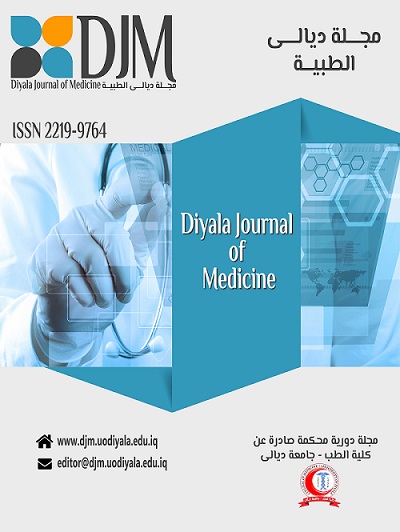Abstract
Background: The correlation of cardiac troponin I with early in-hospital outcomes in acute
myocardial infarction is not well established.
Objective: To assess the role of troponin I in predicting in-hospital outcomes and early left
ventricular systolic dysfunction in patients with ST-segment elevation myocardial infarction.
Patients and Methods: A prospective study which consist of 116 patients (74 were males
and 42 were females), with ST-segment elevation myocardial infarction who had been
admitted to the Coronary Care Unit from March 2015 to September 2015 were enrolled.
Patients were divided according to the level of troponin I on admission into 3 groups (low,
medium and high elevation).
Results: The mean age (+ SD) of the patients was 60+11.4 years. The troponin level of
66.2% of males was high compared with 52.4% of females (p=0.002). The incidence of acute
pulmonary edema (21.1%), cardiogenic shock (7%) and early left ventricular systolic
dysfunction (49.3%) was significantly higher among patients with high troponin level
compared with (0%, 0% and 16%, respectively) among patients with low troponin level. All
deaths and cardiac arrest were of high troponin level.
Conclusion: High admission troponin I in ST-segment elevation myocardial infarction
permits early identification of patients at increased risk of major cardiac complications and
death.
myocardial infarction is not well established.
Objective: To assess the role of troponin I in predicting in-hospital outcomes and early left
ventricular systolic dysfunction in patients with ST-segment elevation myocardial infarction.
Patients and Methods: A prospective study which consist of 116 patients (74 were males
and 42 were females), with ST-segment elevation myocardial infarction who had been
admitted to the Coronary Care Unit from March 2015 to September 2015 were enrolled.
Patients were divided according to the level of troponin I on admission into 3 groups (low,
medium and high elevation).
Results: The mean age (+ SD) of the patients was 60+11.4 years. The troponin level of
66.2% of males was high compared with 52.4% of females (p=0.002). The incidence of acute
pulmonary edema (21.1%), cardiogenic shock (7%) and early left ventricular systolic
dysfunction (49.3%) was significantly higher among patients with high troponin level
compared with (0%, 0% and 16%, respectively) among patients with low troponin level. All
deaths and cardiac arrest were of high troponin level.
Conclusion: High admission troponin I in ST-segment elevation myocardial infarction
permits early identification of patients at increased risk of major cardiac complications and
death.
Keywords
Cardiac troponin I
Ischemic Heart Disease.
Keywords
تروبونين القلبي الأول، مرض نقص تروية القلب.
